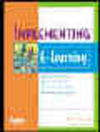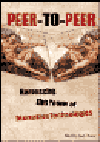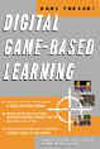Bookshop 2000 to 2002
These are e-learning books added in 2000 to 2002. All books are available from Amazon unless stated otherwise.
Articles in date order, most recent first.
Submit a new Book
| January | February | March | April | May | June | July |
|
August | September | October | November | December |

By Jay Cross and Lance Dublin
"The seventh book in ASTD's E-Learning Series will help you build a powerful implementation and marketing strategy for your e-learning program. This book will show you how to think like a marketing and change management professional by generating awareness for your e-learning brand; position well designed e-learning for maximum effect; develop and implement an effective two-way communication plan; and get your organization ready to accept e-learning. This book is a guide that will enable you to successfully implement e-learning by applying proven techniques from change management and consumer marketing with the ultimate goal of real business results for your organization."
Added: 4 December 2002
Reviewer's Note:
Available from ASTD Sotre, More information (http://www.meta-time.com/book/index.htm)

By Gilly Salmon
"Gilly Salmon's new book E-tivities: the key to active online learning e-tivities is published this week. The book explores e-tivities - the name she gives to frameworks for enhancing active and participative online learning by individuals and groups. All the e-tivities that she discusses are based on low-cost computer mediated environments such as bulletin boards or forums. E-tivities are cheap and do not require equipment beyond the Internet and an interactive online platform as a setting for the interaction between people. These are usually text-based and asynchronous. They are scalable and customisable!"
Added: 6 September 2002
Reviewer's Note:
Cultivating communities of practice: a guide to managing knowledge

By Etienne Wenger, Richard McDermott, William Snyder
"Informal groups known as communities of practice are the latest technique for getting employees to share what they know. Here are seven ways to encourage such communities in your company."
Added: 18 May 2002
Reviewer's Note:
Reviewer's Note: An excerpt from this book is available at CIO Magazine
Designing world-class e-learning

By Roger C Shank
"The majority of today's corporate training programs are weak, ineffective, costly, and hated by the employees they are supposed to train. Worst of all, they are boring. This is the opinion of author, guru, and visionary educator Roger Schank, who argues in Designing World-Class e-Learning, that there his "learning by doing" approach to e-Learning course design offers a dramatic alternative to traditional training-and traditional e-Learning. Schank's approach to e-Learning is based on stories and entertaining case histories told by subject matter experts-in a way that lets students practice-and fail-over and over again in a risk-free computer environment."
Added: 10 November 2001
Reviewer's Note:
How people learn: Brain, Mind, Experience and School

Edited by John D Bransford, Ann L Brown and Rodney R Cocking
"Learning is a basic, adaptive function of humans. More than any other species, people are designed to be flexible learners and active agents in acquiring knowledge and skills. Much of what people learn occurs without formal instruction, but highly systematic and organized information systems--reading, mathematics, the sciences, literature, and the history of a society--require formal training, usually in schools. Over time, science, mathematics, and history have posed new problems for learning because of their growing volume and increasing complexity. The value of the knowledge taught in school also began to be examined for its applicability to situations outside school."
Added: 11 October 2001
Reviewer's Note:
Online version (http://books.nap.edu/html/howpeople1/)

By Nancy Stevenson
"This guide is a great way to determine your best path to success in the virtual world of distance learning. From getting registered to computing the cost of your classes and using the right Web tools, this book can help you stay motivated and achieve your educational goals without ever setting foot in the classroom."
Added: 9 October 2001
Reviewer's Note:
How to be a successful online student

By Sara Dulaney Gilbert
"Offers guidelines and advice to becoming a successful online student, providing the basics of how online learning works. Includes information on how to determine if someone is a good candidate for online learning, advice for what can and cannot be studied online, and how to combine online learning with traditional classes"
Added: 9 October 2001
Reviewer's Note:

By Gerry McGovern, Rob Norton and Catherine O'Dowd
"Good writing is the exception rather than the rule on the Web. One reason for this is simply that good writing is hard to do. Another is that many of the people who've been involved with the Web from the beginning have been slow to realize that writing is a very big part of what the online experience is about." , to be published October 2001
Added: 10 September 2001
Reviewer's Note:
More information (http://www.gerrymcgovern.com/web_content_style_guide.htm)

By Amy Jo Kim
"What makes a Web site a Web community? How have sites like Yahoo, iVillage, eBay, and AncientSites managed to attract and maintain a loyal following? How can Web developers create growing, thriving sites that serve an important function in peoples lives? Community Building on the Web introduces and examines nine essential design strategies for putting together vibrant, welcoming online communities. Amy Jo Kim, a leading expert in Web community design, has helped AOL, Yahoo, Oracle, MTV, and others start online worlds that have become flourishing gathering places that people come back to again and again. The book is full of informative examples, case studies, and tactics for every facet of Web communities, from welcoming visitors to training community leaders."
Added: 4 September 2001
Reviewer's Note:
More information (http://www.naima.com/community/index.html)
Design for community: the art of connecting real people in real places

By Derek M Powazek
"Communities are part of all successful web sites in one way or another. It looks at the different stages that must be understood: Philosophy: Why does your site need community? What are your measures of success? Architecture: How do you set up a site to create positive experience? How do you coax people out of their shells and get them to share their experiences online? Design: From color choice to HTML, how do you design the look of a community area? Maintenance: This section will contain stories of failed web communities, and what they could have done to stay on track, as well as general maintenance tips and tricks for keeping your community "garden" growing."
Added: 11 August 2001
Reviewer's Note:
Peer-to-peer: Harnessing the power of disruptive technologies

Edited by Andy Oram
"This book presents the goals that drive the developers of the best-known peer-to-peer systems, the problems they've faced, and the technical solutions they've found. The contributors are leading developers of well-known peer-to-peer systems, such as Gnutella, Freenet, Jabber, Popular Power, SETI@Home, Red Rover, Publius, Free Haven, Groove Networks, and Reputation Technologies. Topics include metadata, performance, trust, resource allocation, reputation, security, and gateways between systems."
Added: 5 August 2001
Reviewer's Note:
The instructional use of learning objects
Edited by David Wiley
"This is the online version of The Instructional Use of Learning Objects, a new book that tries to go beyond the technological hype and connect learning objects to instruction and learning. You can read the full text of the book here for free. The chapters presented here are © their respective authors and are licensed under the Open Publication License, meaning that you are free to copy and redistribute them in any electronic or non-commercial print form. For-profit print rights are held by AECT."
Added: 27 July 2001
Reviewer's Note:
e-learning: strategies for delivering knowledge in the digital age

By Mark Rosenberg
"Learn what companies like AT&T, Cisco Systems, Dell Computer, IBM, Lucent Technologies, Merrill Lynch, Prudential, and U S West and others have accomplished with e-learning. It isn't just the promise of impressive technology that is driving people to e-learning. Businesses need to get rapidly changing information to large numbers of people faster than ever. They need to lower the overall costs of creating a workforce that performs faster and better than the competition, and they need to do this around the clock. It's no longer a question of whether organizations will one day implement online learning, but whether they will do it well."
Updated: 19 July 2001
Reviewer's Note:

By Jennifer Hofman
"The Synchronous Trainer's Survival Guide is a hands-on resource for enhancing your real-time e-learning sessions. Written by Jennifer Hofmann, a synchronous training leader, it is the first and only book focusing solely on this emerging training method. If you're new to synchronous training, everything you need to know is right here. If you're a seasoned pro the practical tips, tools, and customizable templates in this book will ensure the success of your online training courses, meetings, and events."
Added: 4 July 2001
Reviewer's Note:

By Marc Prensky
"... is a strategic and tactical guide to the newest trend in e-learning - combining content with video games and computer games to more successfully engage the under-40 "Games Generations," which now make up half of America's work force and all of its students. The book fully explores the concept of Digital Game-Based Learning, including such topics as How Learners Have Changed, Why Digital Game-Based Learning Is Effective, Simulations and Games, How Much It Costs, and How To Convince Management. With over 50 case studies and examples, it graphically illustrates how and why Digital Game-Based Learning is working for learners of all ages in all industries, functions and subjects."
Added: April 200
Reviewer's Note:
More information (http://www.twitchspeed.com/site/news.html)

By William Horton
"When the Web based training (WBT) market first began the chief concern of those in the industry was how to go about getting a WBT program up and running. Now that the market has developed design issues involved in creating a Web-based training system have replaced those concerns. This book tackles WBT using text, backed up with illustrations and examples, and presented in a user-friendly manner. It walks the reader through the design and set up of a Web-based training system, covering topics such as: how to find out from potential students what they want in course material, how to perform a needs analysis, general guidelines and standards for Web-based design, what hardware and software to use, how to design the course shell, how will students interact with the course on the Web, and reference aids should be included."
Added: 2000
Reviewer's Note:
The companion website for the book (http://www.designingwbt.com/)
E-moderating: The key to teaching and learning online

By Gilly Salmon
"E-moderators are the new generation of teachers and trainers who work with learners online. There has been explosive growth in online teaching and learning, training, resources and events, and the e-moderator is central to its quality and success. This book, based on Gilly Salmon's considerable experience and research, explains the qualities and competencies required of those teaching, training or developing materials in the online field, and how their skills can be developed. It presents a user's guide to working effectively in the virtual world, backed up with case studies and specific information about how to be a successful e-moderator, along with a collection of resources for practitioners, original research material and learner-oriented consideration of outcomes."
Added: 2000
Reviewer's Note:
The Wired Professor: A Guide to incorporating the World Wide Web into College Instruction

By Anne Keating
"Written for teachers with limited experience of the Internet, this text presents relevant skills and an intellectual framework for understanding and working effectively with it, and provides a practical guide to building and managing instruction-based Web pages and sites. It also incorporates discussions on a variety of topics, from the history of networks, publishing and computers to keenly debated issues such as the pedagogical challenges posed by computer-aided instruction and distance learning. These discussions are offered with an eye to allowing instructors to maximize use of the Internet as a creative medium, a research resource of unparalleled dimension, and a community-building tool. There is also a companion Web site containing additional material such as discussions on design and links to the resources referred to in the book"
Added 2000
Reviewer's Note: